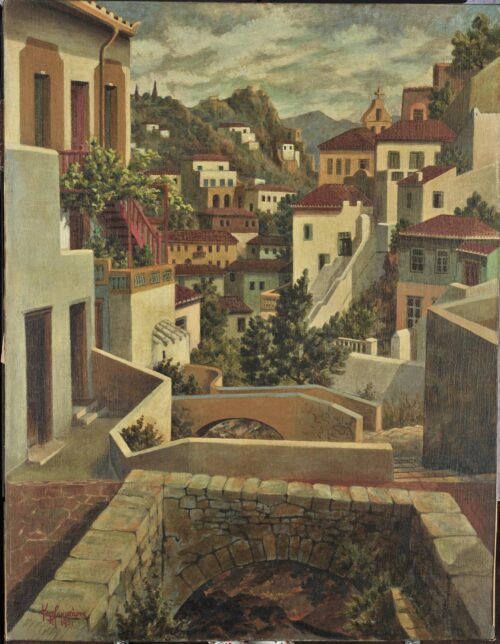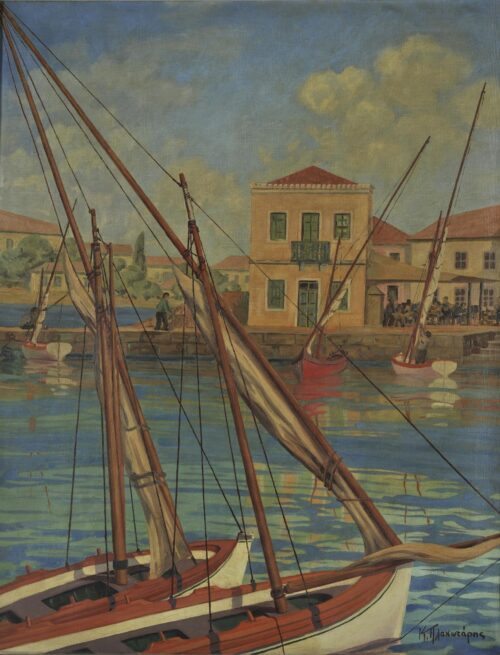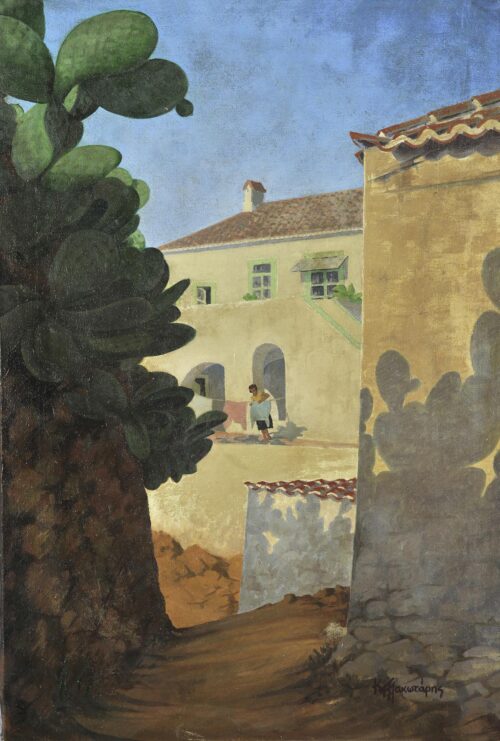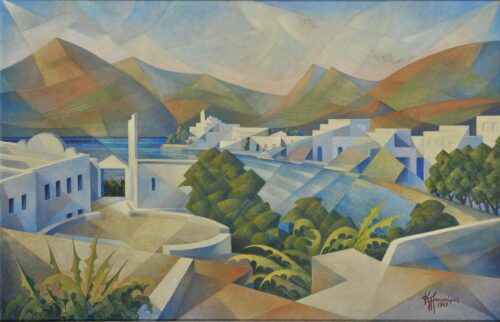
Plakotaris Kostas (1902 - 1969)
Hydra, Road and Bridges, 1951
Kostas Plakotaris received his early instruction in painting at Robert College in Istanbul under K.I. Kotis. In 1922, he went to Germany to study at the painting and printmaking workshops of the Reimann Schule, in Berlin, under the modernist painter and member of the Novembergruppe, Moritz Melzer. In Berlin, Plakotaris also studied political and economic sciences. He moved to Athens in 1925, after spending ten months in Paris. In his biography he noted, “The Cubist movement, then flourishing in Germany, influenced me… Yet, I gradually realized that all these movements – Cubism, Constructivism – were limiting me, and I went back to the study of nature and realism.”
Indeed, especially in the works he made during the mid-War period, echoes of the concerns of analytical Cubism and Orfism are evident: The outlines of the figures, while they still remain recognizable, dissolve; there is increased emphasis on the austere geometry of the composition, and colour, sometimes solid and sometimes graded, intensifies the effect of simplification.
Kostas Plakotaris taught art at the Anargyreios School on the island of Spetses (1930-1935); he taught arts and crafts at Athens College (1937-1940, 1950-1959) and technology of materials at ATI [Athens Institute of Technology] (1959-1961). His extraordinary technical qualifications are documented in his book Media and technique in painting and interior design [Υλικά και τεχνική στη ζωγραφική και διακοσμητική] (Athens 1969). He also worked as art editor of the illustrated magazine “Agricultural Future” [Αγροτικόν Μέλλον] (1937-1941). During the same period (1937-1940), he was a member of the artists’ group “Free artists” [Ελεύθεροι Καλλιτέχναι] and from 1945 to 1947 served as secretary general of the Arts Chamber of Greece [KEE (EETE)]. During the German Occupation he joined EAM [the Greek National Liberation Front].
Plakotaris had solo exhibitions of critical acclaim and participated in group exhibitions, including his first solo exhibition at “Romvos” in 1948, exhibitions at “Zygos” (1959, 1961) and “Nees Morfes” (1966, 1968), the posthumous tribute organised by the National Gallery in 1978, a participation in the Venice Biennale (1936), his contributions to exhibitions by the group “Free artists” (1937, 1939, 1940) and the Panhellenic art fairs in 1938, 1939, 1940, 1952, 1957, 1960, 1963, 1967, as well as the Salon International de l’Art Libre in Paris (where in 1967 he won the Silver Medal).

Hydra, Road and Bridges, 1951

Spetses – Dapia, 1930-1932

Road on Spetses, 1934

View of Paros, 1962

We use cookies to make our site work properly, to personalize content and ads, to provide social media features and to analyze our traffic. We also share information about how you use our site with our social media, advertising and analytics partners. Read the Cookies Policy.
These cookies are necessary for the website to function and cannot be switched off in our systems. They are usually only set in response to actions made by you which amount to a request for services, such as setting your privacy preferences, logging in or filling in forms. You can set your browser to block or alert you about these cookies, but some parts of the site will not then work. These cookies do not store any personally identifiable information.
If you disable this cookie, we will not be able to save your preferences. This means that every time you visit this website you will need to enable or disable cookies again.
These cookies tell us about how you use the site and they help us to make it better. For example these cookies count the number of visitors to our website and see how visitors move around when they are using it. This helps us to improve the way our site works, for example, by ensuring that users find what they are looking for easily. Our website uses Google Analytics for statistics reporting.
Please enable Strictly Necessary Cookies first so that we can save your preferences!